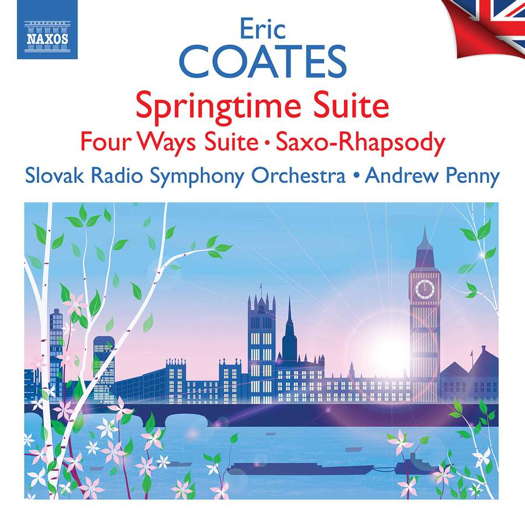 SPONSORED: Think of Something Beautiful - Malcolm Miller pays tribute to contralto Sybil Michelow (1925-2013).
SPONSORED: Think of Something Beautiful - Malcolm Miller pays tribute to contralto Sybil Michelow (1925-2013).
All sponsored features >>
 DISCUSSION: What is a work? John Dante Prevedini leads a discussion about The performing artist as co-creator, including contributions from Halida Dinova, Yekaterina Lebedeva, Béla Hartmann, David Arditti and Stephen Francis Vasta.
DISCUSSION: What is a work? John Dante Prevedini leads a discussion about The performing artist as co-creator, including contributions from Halida Dinova, Yekaterina Lebedeva, Béla Hartmann, David Arditti and Stephen Francis Vasta.
- Günter Wewel
- Sven-David Sandström
- side titles
- Warwick
- Josef Haydn
- Michele Enrico Carafa di Colobrano
- Van Hall
- Ben Nobuto

Magical Stuff
GERALD FENECH listens to Eric Coates' 'Springtime Suite' and other orchestral works
'Andrew Penny and his Slovaks deliver some absolutely gorgeous performances full of warmth, charm and grace ...'
Light music's golden years were during the first half of the twentieth century. Of the countless composers who embraced this genre the name of Eric Coates stands out as a master composer of beautiful melodies and wonderful orchestrations enhanced with a refinement, sophistication and truly orchestral sense that few light-music composers could match. Born in Nottinghamshire in 1886, Coates had a pedigree classical training at the Royal Academy of Music, and he started his musical journey as a freelance viola player, rising to principal viola of Henry Wood's Queen's Hall Orchestra in 1913. In 1919 he left this post to dedicate more time to composing songs and light music, writing in all 160 songs, thirteen suites, four fantasies, a ballet, seventeen marches and twenty-four other short orchestral pieces.
This album contains a selection of these major and shorter orchestral works. The Four Ways Suite (1927) was Coates' fifth suite and dedicated to his friend and conductor Basil Cameron. It was premiered at the Harrogate Festival on 23 September 1927, and its four movements take their ideas from different parts of the world. 'Northward' is a march using the Scottish tune 'Ca' the Yowes'. Incidentally, this was the composer's first march. The second movement is an Italian-sounding waltz. The third a Chinese-sounding scherzo and the fourth glances towards America and its jazz and dance rhythms.
Listen — Eric Coates: West (Four Ways Suite)
(track 10, 0:00-0:55) ℗ 1998 Naxos Rights US Inc :
In the late 1920s Coates and his wife bought a house by the sea at Selsey, Sussex, and these surroundings inspired a whole series of short pieces. Lazy Night (1932) and By the Sleepy Lagoon (1930) were two such works, but it was the latter that was to become an unprecedented hit. At first it attracted only moderate success, but by the 1940s the piece was transformed into a slow foxtrot by an American dance orchestra, and it not only became Coates' second great money-making success but also the signature tune of the BBC programme Desert Island Discs.
Listen — Eric Coates: By the Sleepy Lagoon
(track 1, 0:00-0:56) ℗ 1998 Naxos Rights US Inc :
By the end of the 1940s decade a Coates march, with its energy and optimism, came to reflect the nation's mind at the time. The Eighth Army March was dedicated to General Montgomery and the Eighth Army for their Alamein victory in October 1942, and the piece was also used by the BBC as a signature tune to its Middle East transmissions.
Listen — Eric Coates: The Eighth Army March
(track 11, 0:00-0:36) ℗ 1998 Naxos Rights US Inc :
Footlights Waltz and the romance Last Love both date from 1939; two miniature gems full of delectable tunes. Springtime was Coates' eleventh suite, and one of his finest, though it never achieved the popularity of the others. Composed in 1937, its first movement, 'Fresh Morning', with its jaunty 6/8 rhythm, seems to reflect the age before the First World War and the music of Edward German.
Listen — Eric Coates: Fresh Morning (Springtime Suite)
(track 2, 0:00-0:55) ℗ 1998 Naxos Rights US Inc :
The second movement, 'Noonday Song', with its soulful violin solo, conjures up a memory of a lost age, while the third, 'Dance in the Twilight', is a modern and optimistic waltz.
In 1936, Coates composed his only purely abstract symphonic music, a saxophone concerto. Commissioned by Sigurd Rascher, the famous saxophonist, the Saxo-Rhapsody, as it become known, is a nine-minute display of the highest virtuosity which Coates wrote in just less than one month. Cast in one movement, an energetic central 'Allegro vivace' is surrounded by a reflective 'Moderato' section. Up to this day, this concerto is regarded as one of the major saxophone pieces from the earlier part of the twentieth century.
Listen — Eric Coates: Saxo-Rhapsody (Springtime Suite)
(track 5, 8:24-9:14) ℗ 1998 Naxos Rights US Inc :
Years of compositional sterility followed after the end of World War II, but in the last five years of his life Coates entered his final period of creativity with ten works, one of which, The Dambusters March, became his third greatest success.
In 1956 he repeated the same formula with The High Flight March. Written for the film with the same title, this piece was to be his last composition, and sadly it never hit The Dambusters' heights of success.
Coates died in December 1957 aged seventy-one, leaving for posterity a treasure-trove of inestimable beauty, that even today has remained as fresh and soothing as when it was created almost a century ago. This programme was recorded by Marco Polo way back in April 1993, but this timespan has not diminished any of its five-star qualities. Andrew Penny and his Slovaks deliver some absolutely gorgeous performances full of warmth, charm and grace, and when the occasion warrants a change of mood the music livens up to a feisty level that one expects from a marching tune. Magical stuff from start to finish. Volume 5 is eagerly anticipated; hopefully its availability is just round the corner.
Copyright © 21 January 2022
Gerald Fenech,
Gzira, Malta

CD INFORMATION - ERIC COATES: SPRINGTIME SUITE


